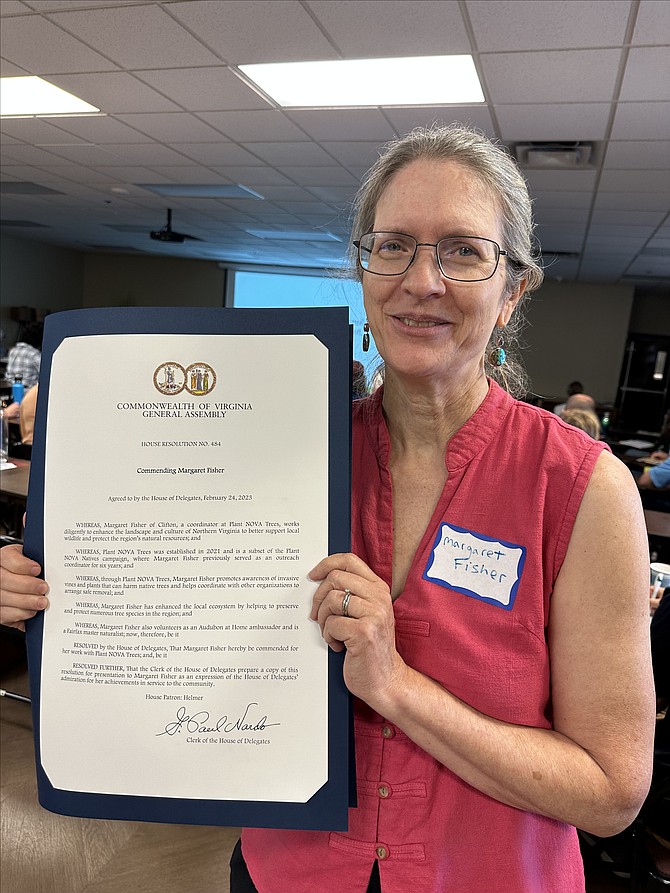Margaret Fisher, a principle coordinator for the Plant NOVA Trees effort and organizer of the professional training conference, received recognition from Virginia’s General Assembly for her many years of work to enhance the landscape and culture of Northern Virginia
Imagine a world without forests. Lands unable to control soil erosion, filter and clean water, control temperatures, store carbon, provide building materials, produce food and medicines, or soothe the soul with the sound of rustling leaves. While we often think that efforts to save forests are needed at far away locations, like the Brazilian rainforest, Africa and other parts of South America, Northern Virginia has a little recognized crisis of its own. Native trees and forests are disappearing here too. Our trees are uprooted by highway and building construction, displaced by aggressive non-native trees, and attacked and killed by alien vines.
Those foreign plants block out the opportunity for native trees and plants to grow where space remains. Plant NOVA Trees, an organization made up of a partnership of non-profit groups, for-profit companies, and government agencies, is calling attention to Northern Virginia’s disappearing native tree canopy, and campaigning not only to plant more trees, but to save the mature trees we have. (For more on their effort to save trees from alien killers, see “To the Rescue!” The Connection, July 13-19, pg 6-7)
In their five year focus on saving trees, running through Fall of 2026, Plant NOVA recognizes “the campaign's success rests on the action of the millions of individuals who make up our Northern Virginia community.” Suburban housing developments have eliminated contiguous woods and left only many separated wood edges - creating the space most ripe for invasive vines and aggressive foreign trees to take hold. With most such land in private hands, Plant NOVA suggests that homeowners could make better use of their existing lawn care services to remove alien plants on their properties and rescue mature trees during their on-going contracted yard maintenance. The group hopes residents will request more native plants for use in home landscapes from designers and in stock available at plant nurseries.
Receiving more requests for native plants and services, many property design, nursery, and lawn and landscaping businesses admit a need for more training for their staff. Employees need knowledge to identify native versus non-native plants, know the preferred growing conditions of various species, and how best to eliminate non-natives. As a means to help better prepare businesses to respond to requests for these services, the Audubon Society of Northern Virginia held a conference in conjunction with Plant NOVA on Aug. 22 for professionals on landscaping for conservation. Hosted by Merrifield Garden Center, the information presented by ecological landscape design firm, Chain Bridge Native Landscapes’ owner, Barbara Ryan, and representatives of local government urban forestry and watershed management, focused on the use of native plants and their role in erosion control and providing riparian buffers. Said Ryan, “I’m happy to do whatever I can to get the word out about the benefits of conserving land and use of natives, to improve the ecology system and address climate change.” Twenty-seven area companies sent staff, including designers, installers, and maintenance staff, to gain more native plant knowledge and share soil erosion and conservation ideas, ultimately to support their customers.
Ryan suggested that as homeowners increasing look for plants resistant to climate change, they will look more and more toward native plants. She advises that such plants, when densely planted as is their preference, provide shade, use less water, absorb carbon, and do better in the heat. Promoting plants and green space in this way is part of Fairfax County’s Community-wide Energy and Climate Action Plan (https://www.fairfaxcounty.gov/environment-energy-coordination/climate-planning-action).
The good news is that horticulture improvements can be less expensive than making the structural changes for soil conservation that would be needed if native plants die en masse. Ryan says that clients typically now ask to replace turf grass for more environmentally friendly options. Starting small and gradually replacing grass and non-native plants over time can make a positive environmental change with less cost and require less weeding effort in the first years. She also advises that “most invasives can be removed successfully without herbicides on home properties.” The practice also keeps costs lower.
Other speakers included Maria Harwood, of Fairfax County’s Urban Forest Management; Clay Morris of Prince William County’s Watershed Management; and Margaret Fisher of Plant NOVA Natives.
What is considered a native plant? A native evolved within the local food web and has sustaining relationships with insects, animals and other plants in its ecosystem. Because many living things evolve to deal with specific circumstances and because that evolution takes a very, very long time, many native plants cannot survive the onslaught of invasive plants introduced into their environment. Sources of information on the Commonwealth’s natives include: “Flora of Virginia,” by Alan Weasley, J. Christopher Ludwig, and John F. Townsend; and Virginia’s Department of Conservation and Recreation’s plant brochures by region, found at
https://www.dcr.virginia.gov/natural-heritage/document/cp-nat-plants.pdf.
The Plant NOVA Natives website lists design and care professionals who are willing and able to concentrate on native plants, provides lists of recommended native plants for Northern Virginia, and a vast amount of other information.
https://www.plantnovanatives.org/
